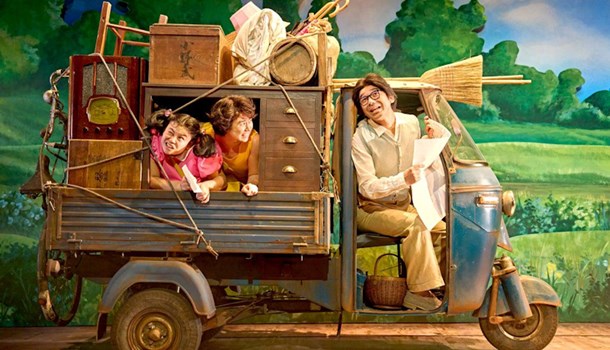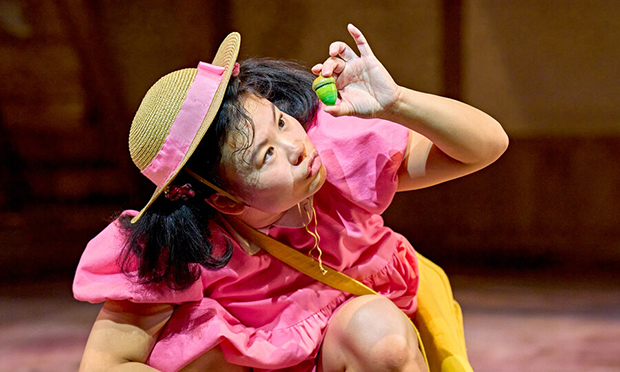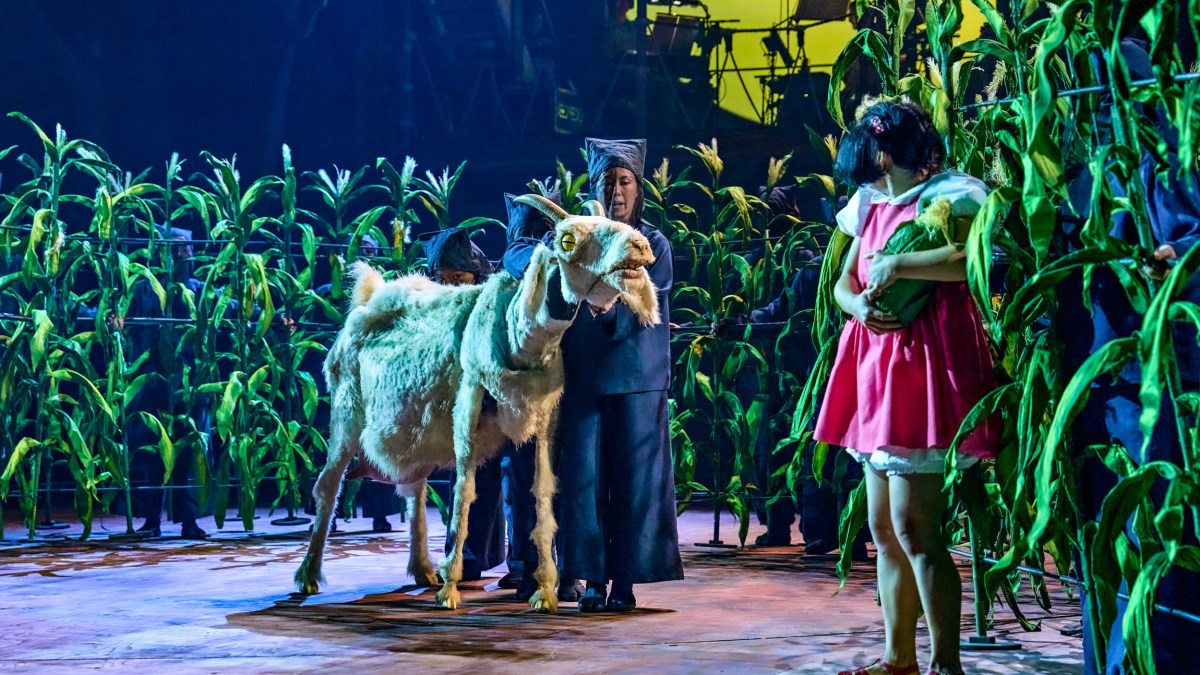
Written by Richard Durrance on 28 Nov 2023
Sometimes fortuitous events occur. I have no idea why when the Barbican email came into my inbox Thursday lunchtime I decided to click the link and check ticket availability for the coming Saturday. All I know is that I saw two tickets for about 140 quid. Then I checked the availability for that same Thursday evening and there was one single seat left, right at the front of the stalls before the stage for a mere £25. What was wrong with this seat? Who knew but damn it, with most of the tickets close to, and well over one-hundred pounds, it was worth a punt.
I clicked away to see if this was an anomaly and then imagine my disappointment when the ticket had disappeared.
Resigned to an evening of without Totoro I then realised I’d added it to my basket by mistake – this time a fortuitous idiot mistake. Yes, I had snagged the ticket and so I paid my hard-earned cash for it (including the ludicrous four quid booking fee, grrr...)
Well folks, if you see the same situation just buy the ticket immediately because dammit, it’s a cracking view and a great way to really, really see the performance, a new run of the Royal Shakespeare Company's stage adaptation of My Neighbour Totoro (and yes, they did add the “u”).
Honestly, I’m not a big fan of the theatre, I tend to be disappointed, but in the last year I’d seen a couple of things; Life of Pi (only because my friend was in it as an understudy so managed to see him on stage but to be fair it was really good) and The Accidental Death of an Anarchist, which was a total riot – watch it for the bonkers Scotland Yard police office body-slam dance sequence! Given these positive experiences I figured that I should branch out from my normal weekend BFI Southbank lunchtime film ventures. Perhaps that was why I checked out the link in the email? It would make sense.
I also live in horror of being disappointed. I’d seen so much positive buzz around the theatrical adaptation of My Neighbour Totoro, that even though I’d not watched the film for years, I really did not want to be walking out thinking it was only "fine" or "good". Still, I rocked up to the Barbican, managing for once not to get lost in it, hovered around outside, taking in the wonderful concrete brutalism of the place as well as watching those around me. Some people I could tell were for the theatre showing and not the musical shows - the cat bus headgear might have given it away. There was a serious hard sell on Totoro merchandise and to be fair it looked decent, but you could tell The Barbican and the production company knew they were on to a good thing and happy to find things to sell people (If you want a cynical hard sell try taking a 4 year old to a Hey Duggee theatre experience where they're waving a stick plush in your face! - Ed).
Tat aside, you're here for the play, but the waiting is part of it. When I sat down, I found the chap sat next to me had also bought his ticket that day, was surprised it was so cheap and was attending because his daughter had suggested he go. He didn’t know it was based on a Miyazaki film, and during the interval he mentioned how he found Miyazaki overly optimistic and praised the Pluto anime that Ross recently reviewed.
So not only did I enjoy the architectural brutalism but had an interesting chat and some good advice for East London walking: yes, East met West London without tension. Cliches really do die.
But it was time for the curtain to rise and the play to begin...
Where to begin?
The first thing you are told is "no photography" (and knives and forks)! Let others discover the adaptation in the same way as you do, without spoilers. This seemed fair given that this team of people can try and take a view of the world such as Miyazaki has and create something true to it without too much foreknowledge. Or not.
The cast ask that you don't take pictures, wanting each audience to discover this theatrical take on a legend's work for themselves, and this seems fair. For most the only real question is whether or not it will be true to the film and how the animation can be adapted for a new medium. Happily it's very much true to the film, it had to be, so it is in the construction, the performances, the vision for how to make animation work on stage. To undermine the film’s tone would be to lose your audience and right from the first moment, as the three-wheeler laden with furniture pootled onto the stage, with father and young daughters: Mei and Satsuki, something about the visual effect left me thinking we were in good hands. Yet there was another two-hour and forty-five-minutes left (including a 20-minute wine interval, and for those new to the venue, if in the stalls do not go to the stalls bar, but the one near the cloakroom as there's almost no queue). For a runtime of this length the mood has to be maintained, creativity sustained, often built upon, increased, slowed down, to be true to each iconic animated moment.
Almost immediately the creativity was visible in the set, the complex movement of the house the family are moving to, the effortless nature of its movement around the characters as they travel towards it speak of the effort in the design and the precision of the preparation. It seems so easily done but must have been born of sweat and tears and considerable frustration, but to us it is utterly beguiling and seamless. If this seems an odd place to start it matters because, throughout the production, the mechanisms of visual storytelling become so integral to the play's success that the inventiveness and precision required to ensure it flows smoothly are quite staggering. Any interruption would have dislodged us from the world laid out before us. Marvel at how the house rotates and walls move to create a hospital bedroom, or else how the puppeteers’ feet are connected to small rice paddies that they move onto the stage like a piece of dance. Each aspect is essential to the success of how the production affects you. Key scenes are beautifully crafted - the first meeting of Totoro and the younger daughter, Mei as she climbs up onto his belly. The cat bus arriving at the bus stop, Totoro with his umbrella. All impeccable.
The staging of this is immaculate, and as often with puppetry on stage as I saw in Life of Pi, the puppeteers become part of the action, especially with the soot sprites, some of which were clearly dangled close to the front rows (more reason to get those front seats) with a smile by the puppeteers. Moreover, it retains the humour and the sense of affectionate glee at these creatures, which never veers towards cutesy, so in tone the play always feels very much in tune with the film, moving through the emotional gears as scenes require.

Which leads one inexorably to the performances. Most of the players double as puppeteers, except our two leads: Satsuki (Ami Okumura Jones) and Mei (Mei Mac), who get the majority of the time on stage. The standout for me was certainly Mei Mac, and here my front row tickets were a luxury as it afforded me a view of her performance that others further back, even in more costly seats, may have missed. She captured the physicality of Mei, the awkward jutting limb and the scrunched face, as well as the emotional insecurities and confusion of such a young girl brilliantly. Yes, it’s definitely a theatrical performance but this is theatre and there is the need to project, but she just gets the all limbs and enthusiasm and obstinacy so right, and I realise it could easily have turned into a millstone part - one that annoys - but Mei Mac is a joy to watch (for those who like their silent film you could say she aims for a Mary Pickfordesque ability to embody a child, and does a damn good job). Arguably it’s a prime role as it gives scope but you have to take it, use it, take it real, and she really, really does, especially when viewed from mere feet away. But she wasn’t "just" an anime character on stage but inhabited the role and seemed to be having a whale of a time throughout.
The other key aspect is the music by Joe Hisaishi, which you could argue comes more alive here because the performance really brings it to the forefront. Music and song, by Hisaishi, is used throughout and performed live, the musicians above the stage in a treehouse. The songs are intriguingly staged because the vocals move from Japanese to English, sung by Ai Ninomiya, who sometimes appears on stage and often not. The change of language you suspect is to capture the sound of the original music as well as to make the meaning clear to those watching who like me are not polyglot. It’s effective though and Ai Ninomiya becomes like another character, adding emotional resonance to what we see on stage.
And then there is Totoro, because when Totoro is on stage, Totoro is on stage. As is the cat bus. These key moments are beautifully staged, and performed, yet they never undermine the more low-key aspects of the play. It would have been easy for the production to have got lost in technical largesse and forget the emotional core of the story. Instead, the play imbues the same sense of awe and wonder that the film does and adds to the emotional impact. The final sequence with the cat bus is a joy, which brings together so much of the creativity of the production into sharp focus. It’s elegant, joyous and again seems so effortless but you can sense the invention and care behind it.
What really impresses is how the play carves its own space – it takes Miyazaki’s story and finds its own unique way to create a world of equal delight. It has its own flow. It also gets the emotional aspects of the story spot on and I felt myself feeling strangely emotional as the production reached it crescendo.
If there is a moral to this review it is to grab a ticket if you can. I rocked up alone, randomly, on the third night, because I just did, and witnessed a wonderful performance that doesn’t rely on knowing the original material. It never drags either, which I remember in Life of Pi, for a brief period towards the end where the play seemed to get bogged down creatively and narratively. Yes it was a short period but it detracted from the joy of watching it, whereas Totoro simply gets better and better as it goes on. The applause lauded on the performers at the end was certainly earned, just reward for a bravura performance.


Long-time anime dilettante and general lover of cinema. Obsessive re-watcher of 'stuff'. Has issues with dubs. Will go off on tangents about other things that no one else cares about but is sadly passionate about. (Also, parentheses come as standard.) Looks curiously like Jo Shishido, hamster cheeks and all.
posted by on 06 Aug 2025
posted by Ross Liversidge on 16 Jul 2025
posted by Ross Liversidge on 14 Jul 2025
posted by Caitlyn C. Cooper on 18 Jun 2025
posted by Ross Liversidge on 04 Jun 2025
posted by Ross Liversidge on 30 May 2025
posted by Ross Liversidge on 25 May 2025